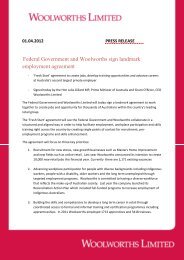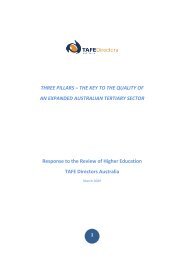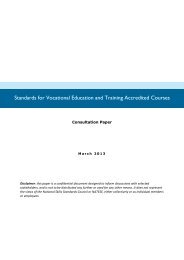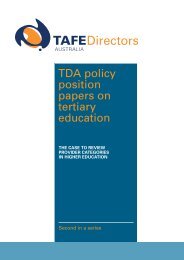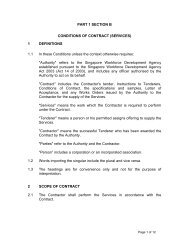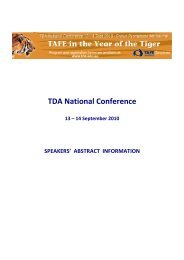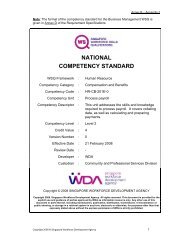Occasional Paper - TAFE Directors Australia
Occasional Paper - TAFE Directors Australia
Occasional Paper - TAFE Directors Australia
Create successful ePaper yourself
Turn your PDF publications into a flip-book with our unique Google optimized e-Paper software.
66<br />
Marketing the <strong>TAFE</strong> brand<br />
<strong>TAFE</strong> is the only brand that can be sold cohesively in<br />
an international market.<br />
The <strong>TAFE</strong> brand should be ‘transformational and<br />
inclusive’.<br />
• <strong>TAFE</strong> offers choice, and support for transition<br />
and pathways.<br />
• It is a community partner and capacity builder.<br />
• <strong>TAFE</strong> sees it as a social obligation for the<br />
‘whole person’, enabling success and career<br />
progression.<br />
To position itself for competitive advantage, and to<br />
have an aspirational and transformational impact,<br />
<strong>TAFE</strong> should use the stories of success and social<br />
media as the new ‘word of mouth’ advertising with<br />
young people.<br />
• <strong>TAFE</strong> has life changing ‘before and after’<br />
outcomes.<br />
• <strong>TAFE</strong> impact can be ‘career defining’.<br />
The use of mandatory entry requirements for entry<br />
level training is a threat to the fulfilment of the<br />
<strong>TAFE</strong> brand’s potential – especially for youth and<br />
disadvantaged people. In a world of rebranding,<br />
public providers should maintain <strong>TAFE</strong> as a ‘sub<br />
brand’. A strong point of difference is in trust,<br />
pastoral care, and active teaching.<br />
We need to acknowledge that there are divided<br />
views on the merits of public providers positioning<br />
together. <strong>TAFE</strong> institutes will promote individuality<br />
in a contestable market, resulting in competition<br />
between <strong>TAFE</strong>s.<br />
Youth<br />
We should have both a funding model and an<br />
education planning model that provide for analysis<br />
of need and case management. These models need<br />
to be ‘co-constructed’ (not mutually exclusive).<br />
Good schools transition and pathway planning are<br />
essential.<br />
Our ‘emerging’ clients<br />
To address the needs of ‘emerging’ clients, <strong>TAFE</strong><br />
needs to understand the market segments, and<br />
identify specific needs and demands. <strong>TAFE</strong> should<br />
use technology appropriately, and develop delivery<br />
materials that are tailored and customised to clients’<br />
needs. <strong>TAFE</strong> should provide ‘whole of organisation’<br />
solutions and develop innovative partnerships with<br />
industry.<br />
• We must ensure that pedagogies are relevant to<br />
each market segment and provide appropriate<br />
professional development for staff.<br />
• <strong>TAFE</strong> should ‘value add’ to industry, for<br />
example, with ‘job ready’ clients through work<br />
placements.<br />
Competencies – key messages<br />
Are training packages relevant in a 21st century<br />
knowledge-based economy<br />
There is a need for a ‘looser’ system of competencybased<br />
training (CBT) and moderation of assessment<br />
across all VET providers.<br />
Most people acknowledge the notion of training<br />
packages as a very sound platform. Industries have<br />
diversified, technological environments can be too<br />
specific for training package competencies and do<br />
not generally meet the broader needs of industry.<br />
However, elements within competencies can be<br />
too prescriptive which can be a barrier to meeting<br />
specific industry/enterprise needs.<br />
Young people prefer to build their own learning/<br />
training programs, so customisation needs to be<br />
engaging. The language in training packages is<br />
complex.





